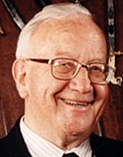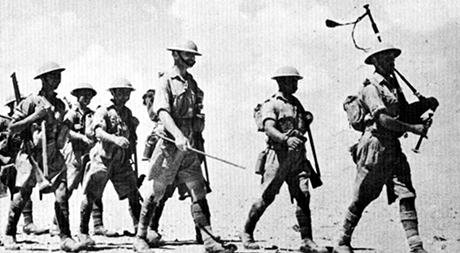The late piping historian and military music expert Lt. Col. David Murray continues his examination of the origins of the pipe band. You can read earlier excerpts here and here.

The influence of John MacAdam’s road surface also had its effect on the music. On the line of march, the Pipes and Drums and the Military Band played alternately, the Military Band usually being stationed half way down the column. The ‘double tap’ on the bass drum also served as the signal for the other band to get ready to take over. In the old days, marching in step was confined to the drill ground or parade square so the marches did not have to be very long.
Most marches of the period usually consist of a couple of eight bar phrases repeated. With the improved roads, more variety and longer tunes came to be demanded, as much by the soldiers as by the pipers. The early pipe marches were often folk tunes, dances, and song airs. In their original form these were boring for the pipers to play so they were played ‘diminished’ that is with all note values halved. The tune Killiecrankie is a case in point. The song air is what we hear nowadays, but there exists a good 4 part 2/4 march, very rarely played now, in which the crotchets of the song tune are played as quavers, the quavers as semi-quavers and so on. This process also served to show off the pipers’ fingering dexterity.
The pipe marches composed for the marching pipe band now tended to have four parts – The 79th’s Farewell, The Barren Rocks, My Native Highland Home, and The Atholl Highlanders, The Blue Bonnets, Pibroch o’ Donuil Dubh. It also became customary to play two or more two- part marches one after the other, the first per-haps four times then changing to the second, or the first once through, change to the second, then back to the first, playing the two as one four- part march. This was called playing them ‘double barrelled’.
[wds id=”2″]
The procedure was for the Pipes and Drums to play a four-part march five times over, making three ten minute sessions. In between, the baton was handed to the Military Band who played their march card three times. Tom Reid, brother of the famous Bob, considered this to involve too much playing. He had served in the Royal Scots Fusiliers and I can remember him sounding off to this effect in Bob’s back shop at 60 George Street, Glasgow.
Now the object of this procedure was to ease the burden for the marching infantryman whose load until the beginning of World War 2 was a heavy one, some 60lbs being about the average. The aim was to set a steady marching pace, as nothing could infuriate the soldiers more than constant changes of step and time. In this the drummers were the key men, the bass drummer the kingpin of the corps of drums. The beatings were simple by modern standards. They can be seen in the two volumes of ‘The Army Manual of Bagpipe Music and Drum Beatings’. These two volumes were intended to ease the problems that arose when Massed Pipes and Drums had to be assembled for some of the state occasions or searchlight tattoos popular in the 1930s. The first volume appeared in 1934, the second following in 1937. They were not universally welcomed. Each regiment had its own cherished settings for both pipe tunes and drum beatings, which it was extremely reluctant to alter. [polldaddy poll=9642153]
The earliest recorded instance of a civilian pipe band would appear to be that of the Govan Police, formed in 1885 at the behest of the Chief Constable [The band is pictured up top]. The pipers and drummers were dressed as soldiers, as indeed are the majority of pipe bands today [now altered to more civilian Highland wear]. The history of the pipe band movement is outwith the scope of this article. Suffice it to say that following the appearance of the rod tension drum in 1930 and the success of the Dalziel Highland Pipe Band at Cowal in 1931 equipped with complete set of rod tensioned drums, military and civilian drumming began to follow separate lines of development. The military remained the bastion of tradition and the rope tension drum. The civilian component eagerly set about pushing back the frontiers of knowledge and skill. The two were to come together as a result of World War 2, which broke out on September 3rd, 1939.

The pipers of the competing pipe band had a different outlook from that of their soldier counterparts. Quite simply, while pounding the hot and dusty roads of Egypt and India nobody cared very much about the finer points of tone or whether the grips on the top hand were coming out together. Even on the big occasions when Retreat was beaten in barracks simple tunes were the rule. My Home, The Atholl and Breadalbane Gathering, Stumpie, and The High Road to Linton would do for the ‘set’ while The Green Hills or After the Battle could look after the 3/4 part of the programme. Even in the days before instruction in schools became a feature of the educational scene, pipers in the competing civilian pipe bands tended to be more accomplished players than the soldiers. The tunes they played in competition came from the ‘heavier’ end of the repertoire and precise and clean fingering was demanded, as well as tone.
• To be concluded.
It’s going to be great![wds id=”3″]
















Recent Comments